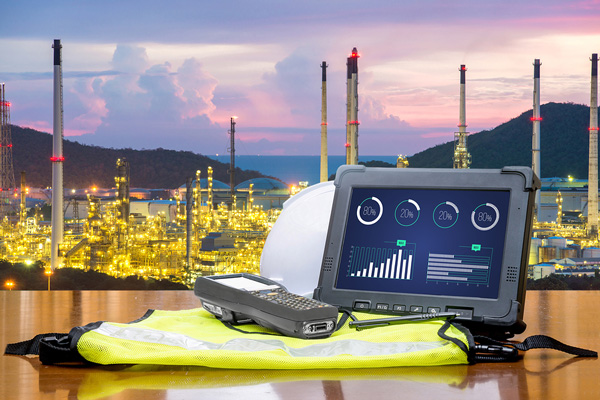What is Enterprise Mobility?
The short answer: “Enterprise Mobility” is a fancy term for using mobile, wireless and handheld hardware devices in an enterprise setting, such as a warehouse, manufacturing shop floor, or in logistics (such as by delivery drivers). These devices open up the ability to mobilize your data as well. Cloud-based software-as-a-service (SaaS) products add an additional layer of mobility on top of that.
Although enterprise mobility represents a suite of hardware, software and people who manage those systems, our discussion will be focused on the hardware aspect of enterprise mobility.

The Current State of Enterprise Mobility
Rapid evolution in mobile, robotic and digital technologies have left a substantial impact on businesses worldwide. In 2010, IT and operational leaders were debating about whether to let line-level workers use mobile devices to carry out their daily tasks. Nearly 10 years later, the use of mobile devices in the supply chain has become the new standard.
Research conducted by B2B research firm MarketsandMarkets revealed that the BYOD and enterprise mobility market size is estimated to double between 2016 and 2021, growing to USD 73.30 Billion by 2021 at a CAGR of 15.87%. Gartner estimates that 2.3 billion devices will be shipped worldwide in 2019 alone, of which 91.79% will be mobile or ultramobile devices.
READ MORE: How a mobile warehouse creates a faster supply chain »
“The mobile landscape has changed dramatically,” said David Willis, vice president and distinguished analyst at Gartner. “Mobile is no longer a novel technology, but business as usual, for most organizations.” He goes on to add: “The proliferation of mobile devices means that phones, tablets, laptops, and wearables are now omnipresent within the business environment, reinventing the way people interact and work.”
In Zebra’s white paper, “Selecting the Right Mobile Device,” the hardware vendor calls this shift in thinking the Workforce Mobility Revolution.
Today, hardware and software developers are pushing more than ever to provide faster and more capable mobile tools to accommodate enterprise mobility strategies. Given so many options to choose from, IT managers and administrators carefully must weigh the pros and cons of each strategic decision in their enterprise mobility management (EMM) policies before jumping into an enterprise mobility solution.
Strategic Considerations: Picking a Device
Many organizations have increasingly allowed employees to use their personal devices in the workplace or while working remotely—a trend referred to as Bring-Your-Own-Device (BYOD). However, consumer devices tend to fall short of the demands of the supply chain in terms of security, ruggedization and high-volume transactions. Purpose-built enterprise mobility hardware like those provided by Honeywell fills these gaps.
But with such a large variety of mobile devices to choose from and so many specialized applications in which to use them, the only question that remains is what type of devices to use.
To answer that question, we will look into three critical strategic elements to consider when choosing devices for your enterprise:
1. The Right OS for the Job
Historically, there have been three options when choosing the right operating system (OS) for your enterprise mobile devices: Microsoft Windows, Apple iOS, or Google Android. Here’s what you need to know about each:
Windows CE
Once popular on industrial devices, Windows Embedded CE has been undergoing a phase-out process since April 2016, when Microsoft ended mainstream support for the latest version of CE 7. CE 6, the most widely-adopted version for 99% of specialty supply chain devices, is now facing end-of-life as well, forcing a migration to other operating systems.
“As a result, support for legacy applications is starting to diminish, new applications are not targeting CE, and the lack of new security protocols support (e.g. TLS1.2) is becoming a significant issue,” said Bruce Willins, an engineering fellow at Zebra Technologies—a leading manufacturer of mobile enterprise devices.
If you are still using Windows Embedded CE 6.0, Windows Embedded Handheld 6.5, or Windows Embedded 8.1 Handheld, the time to make the switch could be running out.
LEARN MORE: Future-proof your OS migration »
Windows 10 Mobile
One of the reasons Microsoft has decided to sunset its Embedded CE operating systems is to push users into migrating to Windows 10 IoT Mobile Enterprise. Win 10 IoT Mobile Enterprise is a comprehensive platform geared to the Internet of Things (IoT) and Industry 4.0. But, while it may have a lot to offer, Willins believes Windows 10 Mobile “may be overkill for traditional CE applications. It is also relatively locked-down so customer extensions often demanded by enterprise users are not likely.”
iOS

As of Q2 2018, iOS accounts for only 11.9% of the global OS market share, according to Statista. Popular in the consumer market and notable for its user-friendly interface (UI), consumer iOS devices tend to draw a higher price tag than their Android counterparts. When it comes to supply chain needs, such as barcode scanning, Apple devices such as iPads and iPhones fall short of the mark in terms of speed, volume and accuracy.
If you are planning on using iOS for warehouse activities like barcode scanning, Zebra offers a software development kit, also known as a “devkit” or SDK, to help maximize worker productivity in scan-intensive environments.
Android: The Clear Winner
With 88% market share of the global market share in 2018, Google’s Android is dominating in the mobile OS space, leaving iOS and Windows far behind. Hardware vendors like Honeywell and Zebra have enthusiastically embraced Android as their go-to OS due to its lightweight architecture and flexibility in being adapted to all types of devices, from tablets to wearables.
“Android has both strategic and tactical advantages. With 80% of the worldwide smartphone shipments, Android brings in extensive development and diagnostic tool support, a familiar UI/UX to end-users, a vast pool of accessible programmers, numerous off-the-shelf applications, and significant innovation,” said Willins. “As an operating system, Android represents a foundation for enterprise-class applications. It’s now proven itself in all major verticals? retail, transportation & logistics, healthcare, manufacturing, government, and education.” (You can read the rest of the interview here.)
2. Device Form Factors: Ruggedized vs Consumer
Mobile devices come in two major form factors: ruggedized or consumer-grade.
Consumer Grade Devices
The phones and tablets we use in everyday life are considered consumer-grade devices, meaning they are manufactured and marketed to individuals. How and what the device is used for is up to that individual. While less expensive than rugged handhelds, consumer-grade devices tend to be relatively fragile as hardware and bloated with unnecessary apps and functionality in terms of software.
Consumer-grade devices running Android or iOS are ideal in that they are widely available, easy to replace, and employees tend to already be familiar with the software, reducing training and onboarding time for part-time and seasonal staff (“seasonality”).
Examples of consumer-grade devices include product lines like the Samsung Galaxy (running Android), iPhone, iPad, and the Microsoft Surface tablet.
READ MORE: BYOD and the Rise of Consumer-Grade Devices in the Supply Chain »
Ruggedized Devices

Compare that to rugged or ruggedized devices, which are designed for high-volume work in harsh environments. That means thicker casing, rubberized shock-resistant corners, fewer internal moving parts and resistance to being dropped or used in dusty or extreme conditions. Semi-rugged, fully-rugged and ultra-rugged are the three generally accepted tiers of ruggedization in rugged IT.
Rugged devices also offer an additional aspect to consider: they are often purpose-built for specific purposes, such as barcode scanning.
Examples of purpose-built ruggedized devices include the Zebra Rugged MC9200 Mobile Computer and the Dolphin CN80 Mobile Computer.
Comparing Total Cost of Ownership (TCO)
According to data released by VDC Research Group and Honeywell, the total cost of ownership (TCO) of consumer devices is actually higher than that of rugged devices. Although less expensive to buy, consumer devices have a high failure rate (about 40%) and must be repaired or replaced more often than rugged devices. The research also shows that 49% of TCO derives from productivity loss due to hardware failure.
Add to this the fact that consumer-grade devices have a shorter average lifespan (only three years) compared to ruggedized devices (five years average life), and the gap between TCO of consumer and rugged devices becomes very clear. In the field service industry, device refresh cycle times have shortened from an average of five years down to three years as well.
READ MORE: Tip for refreshing barcode and mobile device software »
These factors (and several more detailed in the report) reveal the annual TCO of a consumer-grade mobile computer to be $4,234 versus $2,592 for a fully ruggedized equivalent.

3. Field Mobility: Beyond the Four Walls
There is no question that the future of field services lies in mobility.
Traditionally, enterprise mobility has been conceptualized in terms of warehouse operations. Retail store staff, receiving clerks and other warehouse employees use barcode scanners or wearable devices such as ring scanners to track the movement of raw materials, finished goods, inventory and more.
READ MORE: A digital revolution is underway in the warehouse »
With the emergence of cheaper mobile technology, real-time data and a network of ever-improving cellular and Wi-Fi networks (not to mention 5G technology), extending your enterprise mobility strategy outside the four walls is becoming more attractive than ever.
Mobility is becoming a top technology priority for manufacturers, distributors, logistics and other industries that put employees in the field. Field services, route sales, direct store delivery (DSD), consignment inventory sales, and fleet management can all benefit from replacing laptop computers and clipboards with mobile tablets and smartphones to achieve productivity gains.
In addition, it’s no longer good enough for teams to receive new orders in or from the field at the end of the day. Companies that are unable to meet the customer expectation for fast order fulfillment risk being left behind in the competitive landscape. Providing the ability to gather customer delivery confirmation and receipts at the point of delivery can make a big difference in reducing fulfillment cycles while increasing customer satisfaction.
Other technologies, such as electronic data interchange (EDI) and advanced ship notice (ASN) or integration with logistic/transportation management systems (LMS/TMS) can sharpen your supply chain even further.
Next Steps
Enterprise mobility is here to stay. Deciding if you should mobilize your workforce is no longer question—it’s when. But with so many options and so much information about mobile technology for consumers and the enterprise, how do you choose what’s right for your organization?
To review:
- Pick the right OS. Android is popular, flexible and futureproof for the time being, especially if you are looking into ruggedized and/or purpose-built handhelds. Although iOS and Windows 10 Mobile are still options, Android is poised to remain the clear winner for years to come.
- Go rugged or stay consumer. For extreme conditions, such as warehouses, high-volume barcode scanning, dusty or cold environments, go rugged. If you aren’t operating in special or harsh conditions or your team works in an office, consumer-grade may be the way to go.
- Field mobility. Don’t limit your productivity, efficiency and accuracy gains to the four walls. Consider extending that added value into the rest of the supply chain, such as field services and logistics.
Technological innovation and market shifts in operating systems and consumer-grade devices will continue to shape the future of enterprise mobility. At the enterprise level, the choice between ruggedized and consumer devices can be a complex evaluation process that requires an operational area-by-area analysis to determine deciding factors.
When evaluating mobility solutions for your organization or simply refreshing your existing hardware, be sure to choose a vendor that can advise you on which hardware and software options are the best fit to meet your needs and challenges.
Experts on the RFgen team have observed an increasing demand for running enterprise mobility apps across lower-cost consumer-grade devices, especially tablets. RFgen is a device-agnostic automated mobile data collection software platform that deploys on Android, iOS, and Windows operating systems and operates in real-time, offline, and batch modes. This leaves you free to choose the form factor, level of ruggedness, and operating system that works for you and your enterprise.
Addition Reading
- 10 Key Challenges of Enterprise Mobility [Infographic]
- Advantages of Training Warehouse Workers Using Augmented Reality Displays
- Google Glass 2.0 Highlights Accelerating Move to Augmented Reality in the Supply Chain
- Barriers to Rapid AR Headset Implementation in the Manufacturing Space
- Tim’s Hardware Review: Zebra’s TC72 and TC52 Touch Computers for Enterprises





